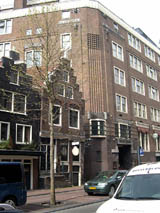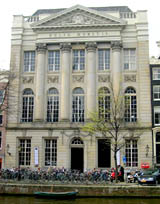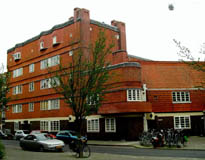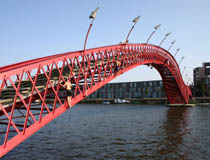Amsterdam architecture
 Throughout the year Amsterdam is one of Europe's foremost architecture and design city, not only because of 17-th century rings of canals. Amsterdam is where modern architecture developed organically between facades of historical buildings. Since it is not a very big city, all sites of interest are within acceptable distance, this is why Amsterdam is so popular with lovers of architecture.
Throughout the year Amsterdam is one of Europe's foremost architecture and design city, not only because of 17-th century rings of canals. Amsterdam is where modern architecture developed organically between facades of historical buildings. Since it is not a very big city, all sites of interest are within acceptable distance, this is why Amsterdam is so popular with lovers of architecture.
Canal rings houses
The old centre was formed by rings of canals with unique mostly 17th century residences of wealthy merchants, financiers, craftsmen, doctors, lawyers, politicians and artists. Because of lack of space, these houses were mostly narrow, not more than 30ft wide (9 meters). They are are characterized by big narrow windows, decorative gable tops, very narrow stairs inside and pulley outside to transport larger objects to upper floors. Very often the residences served also as businesses. Merchant’s houses had their storage in attics and cellars. Sometimes the lift was installed in the middle of the house plan, to transport the goods between floors. The office of the merchant was usually on the ground floor. Like in Venice the canals were the main way of transporting the goods.
 Classicism
Classicism
At the end of the 18th century classicism produced in Amsterdam several monumental buildings, with probably the most interesting called Felix Meritis by Jacob Otten.
Historicism and Art Deco
The development of Amsterdam into the modern city at the end of the 19th century resulted in construction of the several landmark city buildings as Central Station, Central Post Office (today rebuilt into a shopping mall Magna Plaza), Rijksmuseum (State Museum), Stedelijk Museum (Municipal Museum), Stadsschouwburg (City Theater), Concertgebouw (City Philharmonic)and St. Nicolaaskerk. The foremost architect of this was P.J.H.Cuypers. Architecture of these building was searching for the historical inspiration, using elements of gothic and renaissance.
Art Deco popular at the turn of the 19th century in the whole Europe, left several interesting buildings in Amsterdam with the American Hotel as its foremost example with wonderful interior of the café and lunch room.
Hendrik Petrus Berlage
At the beginning of the 20th century an important milestone has been a vast plan of the expansion of Amsterdam into the dimension of the European metropolis, called Plan Zuid (Plan South - 1915) by an architect H.P.Berlage, often regarded as the Father of the Modern Dutch architecture.
Located just near the Dam square the Stock Exchange building (1903, now called Beurs van Berlage and used as exhibition and concert hall) also by the architect Berlage precedes the Amsterdam School style and is often regarded as influential to the whole Dutch architecture of the first half of the 20th.
The Amsterdam School style
 At the beginning of the 20th century, the new housing law in the Netherlands started the boom of the low cost housing for the working class. Most of these quarters were built in a new distinctive style called the Amsterdam School (Dutch: Amsterdamse School). It was first applied by Michel de Kerk is a housing block called Het Schip (The Ship) - today regarded as a monument, with the museum of this architecture style in a former post office.
At the beginning of the 20th century, the new housing law in the Netherlands started the boom of the low cost housing for the working class. Most of these quarters were built in a new distinctive style called the Amsterdam School (Dutch: Amsterdamse School). It was first applied by Michel de Kerk is a housing block called Het Schip (The Ship) - today regarded as a monument, with the museum of this architecture style in a former post office.
Functionalism (1920-1970) and after
As in many other European countries Dutch architecture after 1920 has been influenced by the ideas of the French architect Le Corbusier. New technologies – use of concrete, prefabrication, standardization as well as strongly emphasized function of the building are characteristic for architecture of this movement. The most imprtant architects were Gerrit Rietveld, Jacobus Oud, Johannes Duiker, Cornelis van Eesteren, Michiel Brinkman and Leendert van der Vlugt. The finest examples of functionalism were, still influenced by the Amsterdam School style housing district Betondorp (1921-1928) and Van Gogh Museum, by Gerrit Rietveld (1963-1973).
Later years (before 1990) brought several different streams in Dutch architecture. The most interesting architects of the 1960-1990 in Amsterdam were Aldo van Eyck, Herman Hertzberger. Still, it may seem that functionalism has been heavily influencing new projects.
Amsterdam after 1990
 Modern architecture in the Netherlands after 1990 is one of the most interesting in the world. Interesting realizations include Silodam, the New Islands (Borneo, Java, Sporenburg, KNSM), IJburg. Many Dutch architects who recognized abroad have their works here, including the Rotterdam based star architect Rem Koolhaas, Sjoerd Soeters, Wiel Arets, Benthem & Crouwel, Ben van Berkel, Ton Alberts.
Modern architecture in the Netherlands after 1990 is one of the most interesting in the world. Interesting realizations include Silodam, the New Islands (Borneo, Java, Sporenburg, KNSM), IJburg. Many Dutch architects who recognized abroad have their works here, including the Rotterdam based star architect Rem Koolhaas, Sjoerd Soeters, Wiel Arets, Benthem & Crouwel, Ben van Berkel, Ton Alberts.
Foreign architects include Renzo Piano (Nemo Museum, called before the New Metropolis), Sven-Ingvar Andersson (creation of the new Museumplein), Antonio Cruz and Antonio Ortiz (rebuilding of the Rijksmuseum).
- For old and new Architecture in the Old city centre, the Amsterdamse School: Plan Zuid, Docklands and much more, please tailor your own tour with Amsterdam tours.
